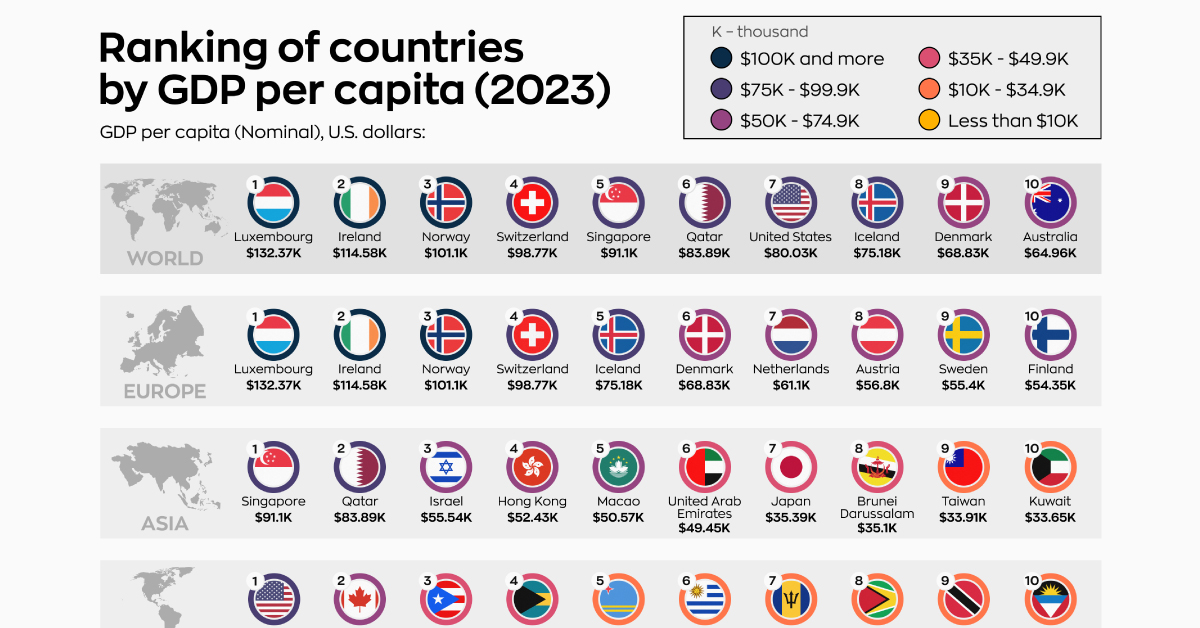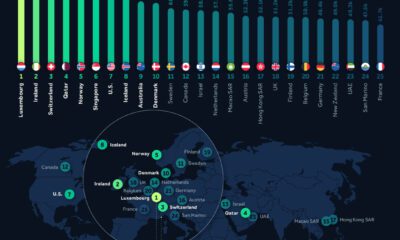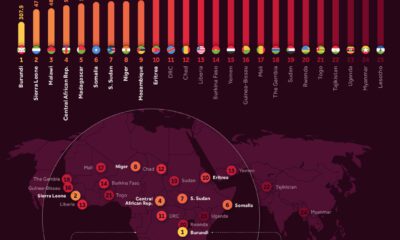GDP
Top 10 Countries By GDP Per Capita, by Region
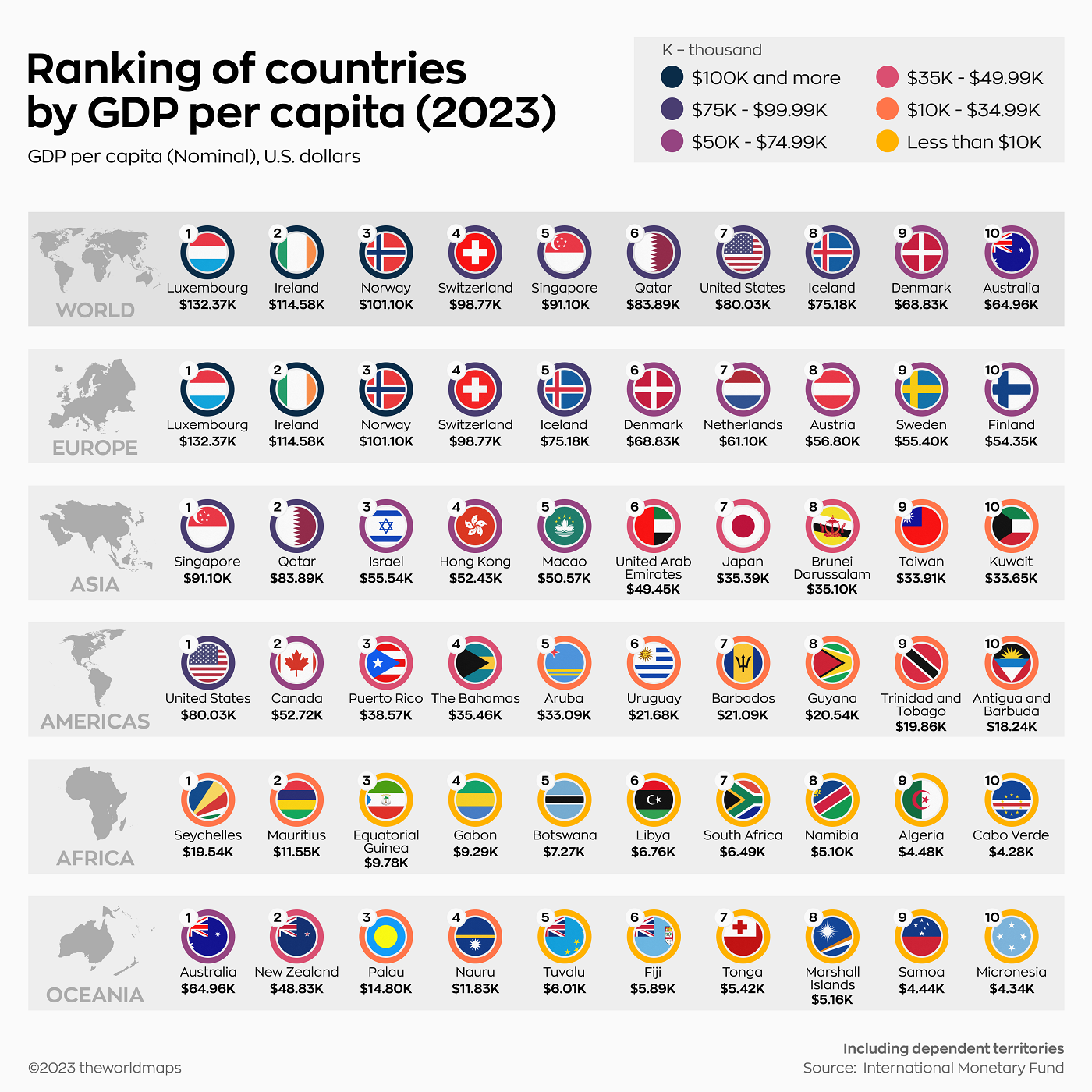
Top 10 Countries by GDP Per Capita in 2023
There are many ways to measure different economies against one another, but comparing countries by GDP per capita remains one of the most tried-and-true methods.
GDP per capita attempts to level the playing field by dividing a country’s economic output by its population, effectively giving the average GDP per person. A higher per capita GDP generally corresponds to higher income, consumption levels, and standards of living.
The simplicity of this metric also makes it useful for economists and policymakers to communicate levels of economic well-being to the public.
The above graphic from theWORLDMAPS ranks the top 10 countries by per capita GDP in different regions, using data from the International Monetary Fund (IMF).
Top 10 Countries by GDP Per Capita in the World
Here are the top 10 countries with the highest nominal GDP per capita in the world in 2023, measured in U.S. dollars:
| Rank | Country | GDP per Capita | Region |
|---|---|---|---|
| 1 | 🇱🇺 Luxembourg | $132,370 | Europe |
| 2 | 🇮🇪 Ireland | $114,580 | Europe |
| 3 | 🇳🇴 Norway | $101,100 | Europe |
| 4 | 🇨🇭 Switzerland | $98,770 | Europe |
| 5 | 🇸🇬 Singapore | $91,100 | Asia |
| 6 | 🇶🇦 Qatar | $83,890 | Asia |
| 7 | 🇺🇸 U.S. | $80,030 | Americas |
| 8 | 🇮🇸 Iceland | $75,180 | Europe |
| 9 | 🇩🇰 Denmark | $68,830 | Europe |
| 10 | 🇦🇺 Australia | $64,960 | Oceania |
Luxembourg, Ireland, and Norway lead the ranking with more than $100,000 in GDP per capita. Luxembourg is a key financial services center in Europe, Ireland is headquarters to many multinational corporations, and Norway is one of the largest energy exporters in the region, explaining their relative prosperity.
Wealthy countries with smaller populations tend to make up the world’s richest ranks. According to the IMF, Luxembourg only has slightly more than 600,000 people which would be a small city in more populous countries. In fact, in the top 10, only the U.S. and Australia have a population of more than 10 million.
Introducing Purchasing Power Parity
One of the major drawbacks of using GDP per capita is that it doesn’t account for the strength of the local currency versus its exchange rate, the latter of which is heavily influenced by investment flows and demand for the national currency.
Non-tradable goods in a country (haircuts, local transport, schools, etc.) do not get valued when using an exchange-rate conversion. It also doesn’t account for the price differences between countries—for example, fresh vegetables in India are far cheaper than in Canada.
To solve this problem, economists utilize purchasing power parity (PPP) indexes. A key element of these indexes is that they remove these price differences and convert into a common currency in order to show relative economic prosperity. Popular examples are The Economist’s Big Mac index and the Wall Street Journal’s Latte Index.
Nominal vs. PPP-adjusted GDP Per Capita
In the case of GDP, PPP measurements use an “international dollar” which can buy the same amount of goods in any given country as a U.S. dollar could buy in America.
Click to view this graphic in a higher-resolution.
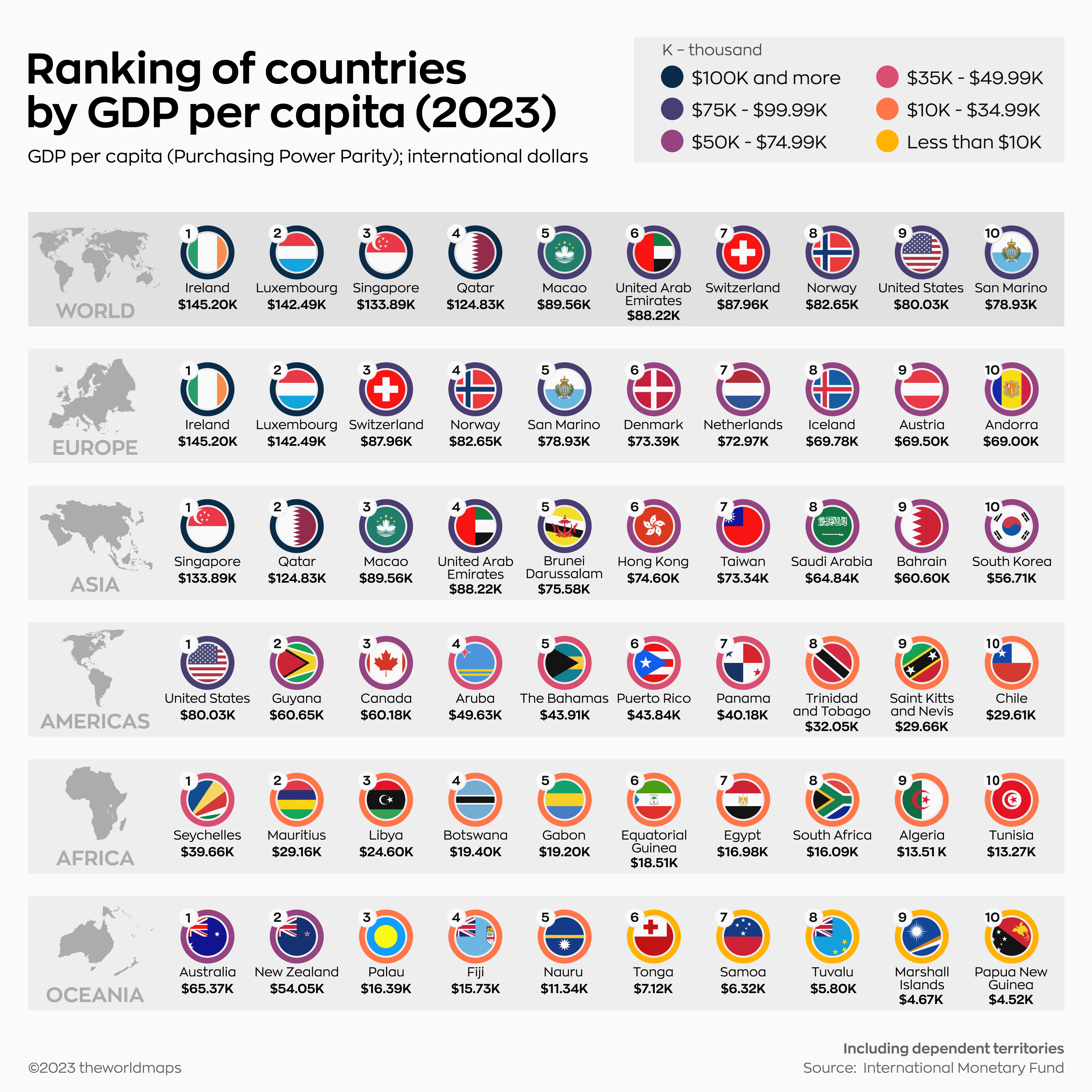
Immediately, there are a few noticeable differences in the top 10 countries by GDP per capita when adjusted for PPP. For one, most countries’ values have increased from their nominal value (except for the U.S. since it is the benchmark).
| Rank | Country | GDP per Capita (PPP) | Region |
|---|---|---|---|
| 1 | 🇮🇪 Ireland | $145,200 | Europe |
| 2 | 🇱🇺 Luxembourg | $142,490 | Europe |
| 3 | 🇸🇬 Singapore | $133,890 | Asia |
| 4 | 🇶🇦 Qatar | $124,830 | Asia |
| 5 | 🇲🇴 Macao | $89,560 | Asia |
| 6 | 🇦🇪 UAE | $88,220 | Asia |
| 7 | 🇨🇭 Switzerland | $87,960 | Europe |
| 8 | 🇳🇴 Norway | $82,650 | Europe |
| 9 | 🇺🇸 U.S. | $80,030 | Americas |
| 10 | 🇸🇲 San Marino | $78,930 | Europe |
Some countries have switched ranks in the top 10, such as Ireland and Luxembourg. Others have been replaced all together, with Iceland, Denmark, and Australia falling out of the top 10, replaced by Macao, the UAE, and San Marino.
We can also see how the different calculations of GDP per capita affect the rankings in other regions:
| Rank (PPP) | Region | Country | PPP (Intl $) | Nominal ($) |
|---|---|---|---|---|
| 1 | Americas | 🇺🇸 United States | $80,030 | $80,030 |
| 2 | Americas | 🇬🇾 Guyana | $60,650 | $20,540 |
| 3 | Americas | 🇨🇦 Canada | $60,180 | $52,720 |
| 4 | Americas | 🇦🇼 Aruba | $49,630 | $33,090 |
| 5 | Americas | 🇧🇸 The Bahamas | $43,910 | $35,460 |
| 6 | Americas | 🇵🇷 Puerto Rico | $43,840 | $38,570 |
| 7 | Americas | 🇵🇦 Panama | $40,180 | $17,350 |
| 8 | Americas | 🇹🇹 Trinidad & Tobago | $32,050 | $19,860 |
| 9 | Americas | 🇰🇳 Saint Kitts & Nevis | $29,660 | $17,860 |
| 10 | Americas | 🇨🇱 Chile | $29,610 | $17,830 |
| 1 | Africa | 🇸🇨 Seychelles | $39,660 | $19,540 |
| 2 | Africa | 🇲🇺 Mauritius | $29,160 | $11,550 |
| 3 | Africa | 🇱🇾 Libya | $24,600 | $6,760 |
| 4 | Africa | 🇧🇼 Botswana | $19,400 | $7,270 |
| 5 | Africa | 🇬🇦 Gabon | $19,200 | $9,290 |
| 6 | Africa | 🇬🇶 Equatorial Guinea | $18,510 | $9,780 |
| 7 | Africa | 🇪🇬 Egypt | $16,980 | $3,640 |
| 8 | Africa | 🇿🇦 South Africa | $16,090 | $6,490 |
| 9 | Africa | 🇩🇿 Algeria | $13,510 | $4,480 |
| 10 | Africa | 🇹🇳 Tunisia | $13,270 | $4,070 |
| 1 | Asia | 🇸🇬 Singapore | $133,890 | $91,100 |
| 2 | Asia | 🇶🇦 Qatar | $124,830 | $83,890 |
| 3 | Asia | 🇲🇴 Macao SAR | $89,560 | $50,570 |
| 4 | Asia | 🇦🇪 United Arab Emirates | $88,220 | $49,450 |
| 5 | Asia | 🇧🇳 Brunei Darussalam | $75,580 | $35,100 |
| 6 | Asia | 🇭🇰 Hong Kong SAR | $74,600 | $52,430 |
| 7 | Asia | 🇹🇼 Taiwan | $73,340 | $33,910 |
| 8 | Asia | 🇸🇦 Saudi Arabia | $64,840 | $29,920 |
| 9 | Asia | 🇧🇭 Bahrain | $60,600 | $28,390 |
| 10 | Asia | 🇰🇷 South Korea | $56,710 | $33,390 |
| 1 | Europe | 🇮🇪 Ireland | $145,200 | $114,580 |
| 2 | Europe | 🇱🇺 Luxembourg | $142,490 | $132,370 |
| 3 | Europe | 🇨🇭 Switzerland | $87,960 | $98,770 |
| 4 | Europe | 🇳🇴 Norway | $82,650 | $101,100 |
| 5 | Europe | 🇸🇲 San Marino | $78,930 | $52,950 |
| 6 | Europe | 🇩🇰 Denmark | $73,390 | $68,830 |
| 7 | Europe | 🇳🇱 Netherlands | $72,970 | $61,100 |
| 8 | Europe | 🇮🇸 Iceland | $69,780 | $75,180 |
| 9 | Europe | 🇦🇹 Austria | $69,500 | $56,800 |
| 10 | Europe | 🇦🇩 Andorra | $69,000 | $44,390 |
| 1 | Oceania | 🇦🇺 Australia | $65,370 | $64,960 |
| 2 | Oceania | 🇳🇿 New Zealand | $54,050 | $48,830 |
| 3 | Oceania | 🇵🇼 Palau | $16,390 | $14,800 |
| 4 | Oceania | 🇫🇯 Fiji | $15,730 | $5,890 |
| 5 | Oceania | 🇳🇷 Nauru | $11,340 | $11,830 |
| 6 | Oceania | 🇹🇴 Tonga | $7,120 | $5,420 |
| 7 | Oceania | 🇼🇸 Samoa | $6,320 | $4,440 |
| 8 | Oceania | 🇹🇻 Tuvalu | $5,800 | $6,010 |
| 9 | Oceania | 🇲🇭 Marshall Islands | $4,670 | $5,160 |
| 10 | Oceania | 🇵🇬 Papua New Guinea | $4,520 | $3,520 |
The Americas and Europe
The U.S. leads the Americas in both nominal and PPP-adjusted per capita GDP. However, Canada drops to 3rd place under the new metric, overtaken by Guyana.
In Europe, the usual suspects in the world’s top 10 populate most of the region’s ranks. However, Andorra slides in at 10th in Europe’s richest countries by GDP per capita (PPP). Andorra in particular benefits from its status as a free economic zone—very low or no taxes—and being a tourism hotspot with the sector contributing 80% to its economy.
Asia
Singapore, Qatar, Macao, the UAE, and Hong Kong claim top spots as Asia’s richest countries on both lists. Qatar and the UAE benefit from oil being a key export of the region, while Singapore and
On the other hand, Israel and Japan drop out of the richest countries in Asia when using PPP calculations, with countries like Saudi Arabia and Bahrain edging them out.
Africa and Oceania
The island nations of Seychelles and Mauritius lead the ranks of countries by GDP per capita in both nominal and PPP categories on the African continent, also thanks to their booming tourism industries.
Traditional African economic heavyweight South Africa also features in this list of Africa’s richest. But Egypt, the region’s third largest economy, only makes the top 10 countries by GDP when adjusted for PPP, otherwise weighed down by its large population.
And in Oceania, adjusting GDP for purchasing power doesn’t have much effect on the sizable gap between Australia and New Zealand and their smaller island neighbors. But some local economies are noticeably stronger when adjusting for PPP, especially Fiji‘s, which has a GDP per capita (PPP) three times bigger than its nominal value.
The Drawbacks of GDP Per Capita
GDP per capita is a useful measure, but it also comes with its own set of caveats.
For one, it is a measurement of economic output per person, not individual income or household savings. That gives it clear limitations in certain cases, such as in Ireland, where the presence of multinational corporations obfuscates the general output per person.
Secondly, countries with smaller populations do better in the rankings. Most of the world’s biggest economies (China, India, UK, France) do not find themselves in the top 10 ranks.
Finally, other metrics for a good standard of living, some of them intangible in economic terms—human rights, freedom of expression—are not accounted for at all.

This article was published as a part of Visual Capitalist's Creator Program, which features data-driven visuals from some of our favorite Creators around the world.
Economy
The $16 Trillion European Union Economy
This chart shows the contributors to the EU economy through a percentage-wise distribution of country-level GDP.
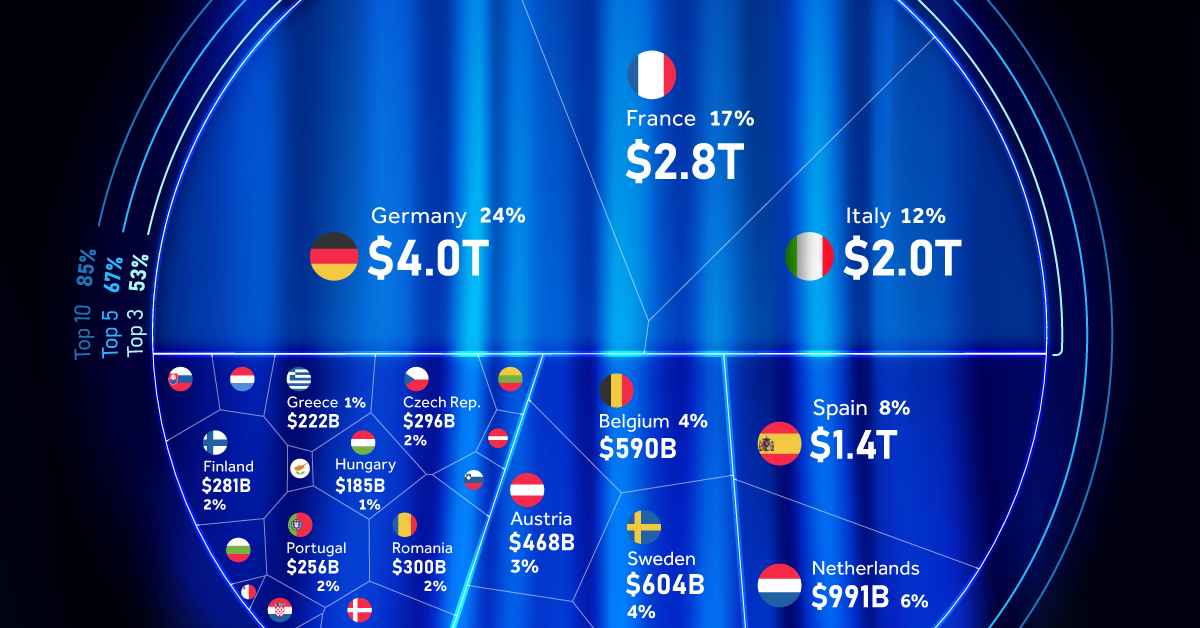
The $16 Trillion European Union Economy
The European Union has the third-largest economy in the world, accounting for one-sixth of global trade. All together, 27 member countries make up one internal market allowing free movement of goods, services, capital and people.
But how did this sui generis (a class by itself) political entity come into being?
A Brief History of the EU
After the devastating aftermath of the World War II, Western Europe saw a concerted move towards regional peace and security by promoting democracy and protecting human rights.
Crucially, the Schuman Declaration was presented in 1950. The coal and steel industries of Western Europe were integrated under common management, preventing countries from turning on each other and creating weapons of war. Six countries signed on — the eventual founders of the EU.
Here’s a list of all 27 members of the EU and the year they joined.
| Country | Year of entry |
|---|---|
| 🇧🇪 Belgium | 1958 |
| 🇫🇷 France | 1958 |
| 🇩🇪 Germany | 1958 |
| 🇮🇹 Italy | 1958 |
| 🇱🇺 Luxembourg | 1958 |
| 🇳🇱 Netherlands | 1958 |
| 🇩🇰 Denmark | 1973 |
| 🇮🇪 Ireland | 1973 |
| 🇬🇷 Greece | 1981 |
| 🇵🇹 Portugal | 1986 |
| 🇪🇸 Spain | 1986 |
| 🇦🇹 Austria | 1995 |
| 🇫🇮 Finland | 1995 |
| 🇸🇪 Sweden | 1995 |
| 🇨🇾 Cyprus | 2004 |
| 🇨🇿 Czechia | 2004 |
| 🇪🇪 Estonia | 2004 |
| 🇭🇺 Hungary | 2004 |
| 🇱🇻 Latvia | 2004 |
| 🇱🇹 Lithuania | 2004 |
| 🇲🇹 Malta | 2004 |
| 🇵🇱 Poland | 2004 |
| 🇸🇰 Slovakia | 2004 |
| 🇸🇮 Slovenia | 2004 |
| 🇧🇬 Bulgaria | 2007 |
| 🇷🇴 Romania | 2007 |
| 🇭🇷 Croatia | 2013 |
Greater economic and security cooperation followed over the next four decades, along with the addition of new members. These tighter relationships disincentivized conflict, and Western Europe—after centuries of constant war—has seen unprecedented peace for the last 80 years.
The modern version of the EU can trace its origin to 1993, with the adoption of the name, ‘the European Union,’ the birth of a single market, and the promise to use a single currency—the euro.
Since then the EU has become an economic and political force to reckon with. Its combined gross domestic product (GDP) stood at $16.6 trillion in 2022, after the U.S. ($26 trillion) and China ($19 trillion.)
Front Loading the EU Economy
For the impressive numbers it shows however, the European Union’s economic might is held up by three economic giants, per data from the International Monetary Fund. Put together, the GDPs of Germany ($4 trillion), France ($2.7 trillion) and Italy ($1.9 trillion) make up more than half of the EU’s entire economic output.
These three countries are also the most populous in the EU, and together with Spain and Poland, account for 66% of the total population of the EU.
Here’s a table of all 27 member states and the percentage they contribute to the EU’s gross domestic product.
| Rank | Country | GDP (Billion USD) | % of the EU Economy |
|---|---|---|---|
| 1. | 🇩🇪 Germany | 4,031.1 | 24.26% |
| 2. | 🇫🇷 France | 2,778.1 | 16.72% |
| 3. | 🇮🇹 Italy | 1,997.0 | 12.02% |
| 4. | 🇪🇸 Spain | 1,390.0 | 8.37% |
| 5. | 🇳🇱 Netherlands | 990.6 | 5.96% |
| 6. | 🇵🇱 Poland | 716.3 | 4.31% |
| 7. | 🇸🇪 Sweden | 603.9 | 3.64% |
| 8. | 🇧🇪 Belgium | 589.5 | 3.55% |
| 9. | 🇮🇪 Ireland | 519.8 | 3.13% |
| 10. | 🇦🇹 Austria | 468.0 | 2.82% |
| 11. | 🇩🇰 Denmark | 386.7 | 2.33% |
| 12. | 🇷🇴 Romania | 299.9 | 1.81% |
| 13. | 🇨🇿 Czechia | 295.6 | 1.78% |
| 14. | 🇫🇮 Finland | 281.4 | 1.69% |
| 15. | 🇵🇹 Portugal | 255.9 | 1.54% |
| 16. | 🇬🇷 Greece | 222.0 | 1.34% |
| 17. | 🇭🇺 Hungary | 184.7 | 1.11% |
| 18. | 🇸🇰 Slovakia | 112.4 | 0.68% |
| 19. | 🇧🇬 Bulgaria | 85.0 | 0.51% |
| 20. | 🇱🇺 Luxembourg | 82.2 | 0.49% |
| 21. | 🇭🇷 Croatia | 69.4 | 0.42% |
| 22. | 🇱🇹 Lithuania | 68.0 | 0.41% |
| 23. | 🇸🇮 Slovenia | 62.2 | 0.37% |
| 24. | 🇱🇻 Latvia | 40.6 | 0.24% |
| 25. | 🇪🇪 Estonia | 39.1 | 0.24% |
| 26. | 🇨🇾 Cyprus | 26.7 | 0.16% |
| 27. | 🇲🇹 Malta | 17.2 | 0.10% |
| Total | 16,613.1 | 100% |
The top-heaviness continues. By adding Spain ($1.3 trillion) and the Netherlands ($990 billion), the top five make up nearly 70% of the EU’s GDP. That goes up to 85% when the top 10 countries are included.
That means less than half of the 27 member states make up $14 trillion of the $16 trillion EU economy.
Older Members, Larger Share
Aside from the most populous members having bigger economies, another pattern emerges, with the time the country has spent in the EU.
Five of the six founders of the EU—Germany, France, Italy, the Netherlands, Belgium—are in the top 10 biggest economies of the EU. Ireland and Denmark, the next entrants into the union (1973) are ranked 9th and 11th respectively. The bottom 10 countries all joined the EU post-2004.
The UK—which joined the bloc in 1973 and formally left in 2020—would have been the second-largest economy in the region at $3.4 trillion.
Sectoral Analysis of the EU
The EU has four primary sectors of economic output: services, industry, construction, and agriculture (including fishing and forestry.) Below is an analysis of some of these sectors and the countries which contribute the most to it. All figures are from Eurostat.
Services and Tourism
The EU economy relies heavily on the services sector, accounting for more than 70% of the value added to the economy in 2020. It also is the sector with the highest share of employment in the EU, at 73%.
In Luxembourg, which has a large financial services sector, 87% of the country’s gross domestic product came from the services sector.
Tourism economies like Malta and Cyprus also had an above 80% share of services in their GDP.
Industry
Meanwhile 20% of the EU’s gross domestic product came from industry, with Ireland’s economy having the most share (40%) in its GDP. Czechia, Slovenia and Poland also had a significant share of industry output.
Mining coal and lignite in the EU saw a brief rebound in output in 2021, though levels continued to be subdued.
| Rank | Sector | % of the EU Economy |
|---|---|---|
| 1. | Services | 72.4% |
| 2. | Industry | 20.1% |
| 3. | Construction | 5.6% |
| 4. | Agriculture, forestry and fishing | 1.8% |
Agriculture
Less than 2% of the EU’s economy relies on agriculture, forestry and fishing. Romania, Latvia, and Greece feature as contributors to this sector, however the share in total output in each country is less than 5%. Bulgaria has the highest employment (16%) in this sector compared to other EU members.
Energy
The EU imports nearly 60% of its energy requirements. Until the end of 2021, Russia was the biggest exporter of petroleum and natural gas to the region. After the war in Ukraine that share has steadily decreased from nearly 25% to 15% for petroleum liquids and from nearly 40% to 15% for natural gas, per Eurostat.
Headwinds, High Seas
The IMF has a gloomy outlook for Europe heading into 2023. War in Ukraine, spiraling energy costs, high inflation, and stagnant wage growth means that EU leaders are facing “severe trade-offs and tough policy decisions.”
Reforms—to relieve supply constraints in the labor and energy markets—are key to increasing growth and relieving price pressures, according to the international body. The IMF projects that the EU will grow 0.7% in 2023.
-
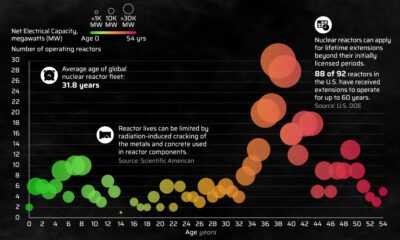
 Energy3 weeks ago
Energy3 weeks agoHow Old Are the World’s Nuclear Reactors?
-

 Countries7 days ago
Countries7 days agoMapped: World’s Top 40 Largest Military Budgets
-

 Markets3 weeks ago
Markets3 weeks agoHow Big is the Market for Crude Oil?
-

 Maps6 days ago
Maps6 days agoMapped: The Safest Cities in the U.S.
-
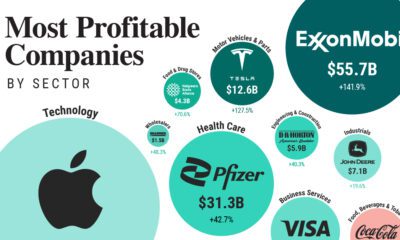
 Markets2 weeks ago
Markets2 weeks agoRanked: The Most Profitable U.S. Companies, by Sector
-

 apps5 days ago
apps5 days agoHow Long it Took for Popular Apps to Reach 100 Million Users
-

 Markets4 weeks ago
Markets4 weeks agoThe World’s Biggest Mutual Fund and ETF Providers
-

 Business2 weeks ago
Business2 weeks agoBrand Reputations: Ranking the Best and Worst in 2023

